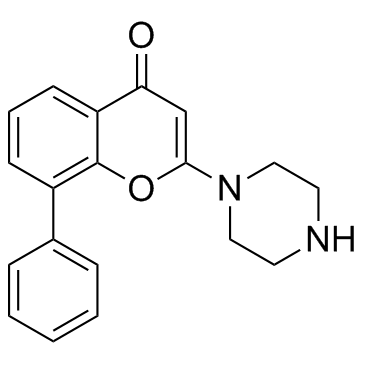| Description |
LY303511 is a structural analogue of LY294002. LY303511 does not inhibit PI3K. LY303511 enhances TRAIL sensitivity of SHEP-1 neuroblastoma cells. LY303511 reversibly blocks K+ currents (IC50=64.6±9.1 μM) in MIN6 insulinoma cells.
|
| Related Catalog |
|
| Target |
TRAIL[2] IC50: 64.6±9.1 µM (K+ currents, in MIN6 insulinoma cells)[3]
|
| In Vitro |
LY303511 is structurally identical to LY294002 except for a substitution of -O for -NH in the morpholine ring, and does not potently inhibit PI3K. Treatment of cells with LY303511 causes an increase in calcein spread similar to levels of LY294002. The ability of LY303511 to increase gap junctional intercellular communication (GJIC) does not occur concomitant with inhibition of phosphorylation of AKT as measured by immunoblotting[1]. LY303511 enhances TRAIL sensitivity of SHEP-1 neuroblastoma cells via H2O2-MAPK activation and up-regulation of death receptors. SHEP-1 cells are exposed to varying concentrations of LY303511 (LY30), TRAIL, and a combination of the two (1 h preincubation with LY303511 followed by TRAIL for 4 hours). SHEP-1 cells are responsive to TRAIL (~10%, ~15%, and ~30% reduction in the surviving fraction at 25, 50, and 100 ng/mL, respectively); however, treatment with LY303511 (12.5, 25, or 50 μM) has no effect on cell viability. However, incubation of cells with LY303511 (25 μM) for 1 hour followed by 4 hours exposure to 50 ng/mL of TRAIL has a strong synergistic effect (~40% reduction in viable cells with LY303511+TRAIL versus ~15% with TRAIL alone)[2]. LY303511 is a negative control compound with respect to PI3K activity. In MIN6 insulinoma cells, Wortmannin (100 nM) has no effect on whole-cell outward K+ currents, but LY294002 and LY303511 reversibly block currents in a dose-dependent manner (IC50=9.0±0.7 μM and 64.6±9.1 μM, respectively). Kv2.1 and Kv1.4 are highly expressed in beta-cells, and in Kv2.1-transfected tsA201 cells, 50 μM LY294002 and 100 μM LY303511 reversibly inhibit currents by 99% and 41%, respectively. LY303511 blocks currents with an IC50 of 64.6±9.1 µM, with a maximal inhibition of ~90% at 500 µM (n≥5 cells at each concentration)[3].
|
| In Vivo |
Intraperitoneal administration of vehicle or LY303511 (10 mg/kg/day) is performed when tumors reach a volume of ~150 mm3, at which time 35 mice have developed a tumor. After 21 days, >15% of the mice require euthanasia because of excessive tumor growth, and these data are censored due to unreliable estimates of average tumor volume. The administration of LY303511, 10 mg/kg/day, is sufficient to inhibit PC-3 tumor growth in vivo[4].
|
| Cell Assay |
Human neuroblastoma SHEP-1 cells are maintained in DMEM supplemented with 10% fetal bovine serum and 1% Penicillin. In a typical survival assay, SHEP-1 cells (8×104 per well) plated in 24-well plates for 24 h are exposed to LY303511 (12.5, 25, and 50 μM), TRAIL (25, 50, and 100 ng/mL), and a combination of the two (1 h preincubation with LY303511 followed by TRAIL for 4 h). Cytotoxicity is determined by the crystal violet assay. After drug exposure, cells are washed with PBS and incubated for 20 min with crystal violet solution (200 μL). The excess crystal violet solution is washed away with distilled water, and the remaining crystals are dissolved with 20% acetic acid. Viability is determined by absorbance at 595 nm wavelength using an automated ELISA reader. Cell viability experiments are performed similarly with 2,000 units/mL of catalase, 4 μM JNK inhibitor SP600125, 10 μM p38 inhibitor SB202190, 20 μM MAPK/ERK kinase (MEK) inhibitor PD98059, 50 μM of caspase-8 inhibitor Z-IETD-FMK or pan-caspase inhibitor Z-VAD-FMK, or death receptor blocking antibodies (4 μg/mL anti-DR4 or 1 μg/mL anti-DR5), or in cells transfected with small interfering RNA (siRNA) for silencing JNK and ERK expression, respectively. Cells are preincubated for 1 h with LY303511 and the respective inhibitor or catalase before the addition of TRAIL. Similar sensitizing effect of LY303511 on TRAIL-induced apoptosis is carried out with SY5Y neuroblastoma, T98G glioblastoma, Jurkat leukemia, CEM myelogenous leukemia, HeLa ovarian carcinoma, and HT29 colorectal carcinoma cell lines[2].
|
| Animal Admin |
Mice[4] Human prostate adenocarcinoma (PC-3) cells (ATCC CRL-1435) are cultured in vitro before harvesting and implantation of 1×106 cells in 20% Matrigel per athymic NCR nude mouse by subcutaneous injection at the flank. Inoculated mice are subdivided into four groups of 10. Administration of vehicle or LY303511, 10 mg/kg/day, is begun (day 1) when tumors reach ~150 mm3 (n=35), and tumor volumes are measured for 30 days at the indicated time points.
|
| References |
[1]. Bodenstine TM, et al. Homotypic gap junctional communication associated with metastasis suppression increases with PKA activity and is unaffected by PI3K inhibition. Cancer Res. 2010 Dec 1;70(23):10002-11. [2]. Shenoy K, et al. LY303511 enhances TRAIL sensitivity of SHEP-1 neuroblastoma cells via hydrogen peroxide-mediated mitogen-activated protein kinase activation and up-regulation of death receptors. Cancer Res. 2009 Mar 1;69(5):1941-50. [3]. El-Kholy W, Macdonald PE, Lin JH, The phosphatidylinositol 3-kinase inhibitor LY294002 potently blocks K(V) currents via a direct mechanism. FASEB J. 2003 Apr;17(6):720-2. [4]. Kristof AS, et al. LY303511 (2-piperazinyl-8-phenyl-4H-1-benzopyran-4-one) acts via phosphatidylinositol 3-kinase-independent pathways to inhibit cell proliferation via mammalian target of rapamycin (mTOR)- and non-mTOR-dependent mechanisms. J Pharmacol Exp Ther. 2005 Sep;314(3):1134-43.
|
